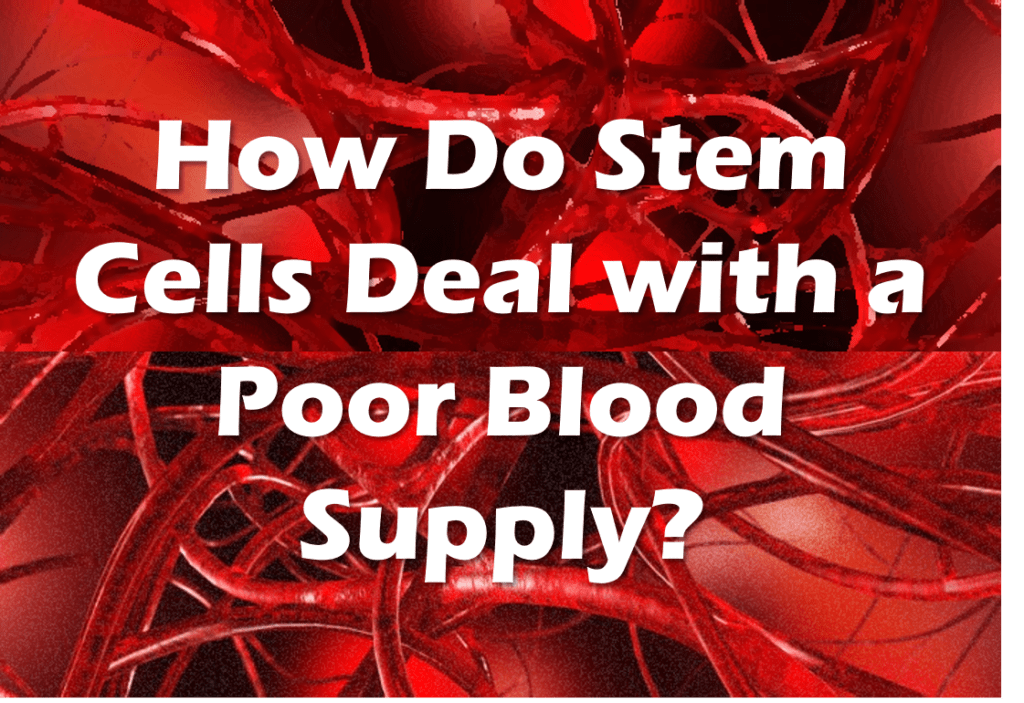Ask Dr. C Episode 21: Stem Cells and Avascular Tissues

I love really thoughtful questions that show that patients are starting to dive deeper. I just had that kind of question wondering how stem cells can deal with low blood flow conditions. Let’s dig in.
The Magic Stem Cell Carpet Ride
One of the more interesting advertisements out there is alternative medicine clinics using IV drips to deliver stem cells. As I’ve discussed many times, the problem with this concept is that many of the places that stem cells should be placed have a poor blood supply, so using an IV is a bad way to deliver cells. In addition, about 97% of the cells get filtered out by the lungs. Hence, the cells need to be precisely placed exactly where they need to go via imaging guidance. The problem is that most of these clinics don’t have providers with this type of rare expertise, hence the IV scam.
The Question
“Hi,
I am a Regenexx patient. I have had both knees done with the stem cell procedure and my neck done 2 times with platelet lysate. All being successful with the exception of my last stem cell procedure in my right knee, however, I am still hopeful because the procedure was only done 3 weeks ago. My question, following your article on How Stem Cells Get to Where They Need to Go. Hoe do stem cells or any cells for that matter exist and flourish in avascular tissues like knee cartilage, menisci and spinal discs?
Thank you,
Bill”
This question is focusing on how stem cells can survive and thrive in poor blood supply tissues. Fair and interesting question, so let’s dig in.
Blood Supply
Your cells need oxygen and many other things and those are usually supplied by small blood vessels. However, some tissues have a poor blood supply, so they must get their oxygen and nutrition in other ways. Our reader points out a few:
–Knee cartilage-Has no blood vessels in it but does have a blood supply from the bone side. The other side of the cartilage is nourished by the synovial fluid in the knee.
–Meniscus-Does have a blood supply on the outer 1/3 with less blood supply in the middle 1/3. The inner third has no blood supply. Those inner and middle third cells are nourished by the synovial fluid in the knee.
–Spinal Discs-These only have a blood supply in the outer part of the annulus and on either side of the spinal bones (vertebrae). The disc cells get their nutrition by imbibition. Meaning that the chemicals in the disc acting like a sponge and pull in and store water with intermittent loading like that which happens with walking.
How Do Stem Cells Deal with these Areas?
Mesenchymal stem cells from bone marrow have a unique trick, they can withstand lots of hypoxia. Meaning that your bone marrow where they originate has parts of it that instead of being 21% oxygen like sea-level air, that have only 1-5% oxygen (hypoxic). Hence, these cells are uniquely adpated to live in low oxygen environments. In fact, that hypoxia keeps them from differentiating and helps them maintain their stemness (the ability to turn into needed cell types).
Stem cells have another trick. They can secrete VEGF or Vascular Endothelial Growth Factor. The purpose of this growth factor is to build new blood vessels. So not only can stem cells withstand hypoxia, but they can also build new blood vessels to help solve that problem. Once they get more oxygen, after a few weeks, they can then begin to engraft into the area by differentiating into a needed cell type.
Putting It All Together
Here’s the summary:
- Stem cells can’t hitch a ride through a blood vessel to get where they need to be because many of these areas have a poor or no blood supply.
- However, stem cells can be placed via precise imaging guidance into these poor blood supply areas.
- Once there, stem cells can survive hypoxia
- They can also build new blood vessels to solve the poor blood supply issue
The upshot? Stem cells can do some pretty cool things. You just need to make sure as the patient that they can be placed in the exact spots where they’re needed!
__________________________________________
References:
(1) Antebi B, Rodriguez LA 2nd, Walker KP 3rd, Asher AM, Kamucheka RM, Alvarado L, Mohammadipoor A, Cancio LC. Short-term physiological hypoxia potentiates the therapeutic function of mesenchymal stem cells. Stem Cell Res Ther. 2018 Oct 11;9(1):265. doi: 10.1186/s13287-018-1007-x. PMID: 30305185; PMCID: PMC6180371.
(2) Hofmann NA, Ortner A, Jacamo RO, Reinisch A, Schallmoser K, Rohban R, Etchart N, Fruehwirth M, Beham-Schmid C, Andreeff M, Strunk D. Oxygen sensing mesenchymal progenitors promote neo-vasculogenesis in a humanized mouse model in vivo. PLoS One. 2012;7(9):e44468. doi: 10.1371/journal.pone.0044468. Epub 2012 Sep 7. PMID: 22970226; PMCID: PMC3436890.

If you have questions or comments about this blog post, please email us at [email protected]
NOTE: This blog post provides general information to help the reader better understand regenerative medicine, musculoskeletal health, and related subjects. All content provided in this blog, website, or any linked materials, including text, graphics, images, patient profiles, outcomes, and information, are not intended and should not be considered or used as a substitute for medical advice, diagnosis, or treatment. Please always consult with a professional and certified healthcare provider to discuss if a treatment is right for you.